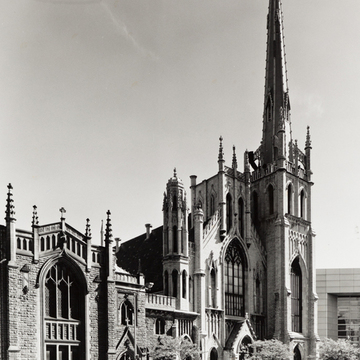This Gothic Revival church of limestone ashlar was originally designed in 1855 by Octavius and Albert H. Jordan, who had migrated three years earlier from Hartford, Connecticut, to Detroit. On the whole, it is late English Gothic. It has a steep gable roof and a large corner tower with a tall, slender, octagonal wood spire utilizing flying buttresses. A smaller tower with an octagonal turret at the northeast corner is modeled after King's College Chapel in Cambridge, England. Stone tracery, pinnacles, tall windows, and narrow buttresses add to the light, lacy, Perpendicular Gothic quality of the church. Inside, the three-aisled nave and the horseshoe-shaped balcony seat about 1,000 worshippers beneath a hammer-beam roof. There is also a solid brass lectern and a baptismal font of Caen stone resting on Mexican onyx columns. Two disastrous fires in 1876 and 1914 destroyed the church, but it was rebuilt each time to almost the original plan. Additions provided for worship, educational, social, and recreational activities. Today, in 2011, with the help of Partners for Sacred Places and the Michigan Historic Preservation Network, the diverse and progressive congregation continues confronting issues of an aging building and a dwindled membership. A capital campaign, Let's Raise the Roof that emerged from New Dollars/New Partners for Your Sacred Place, built leadership and raised funds to replace the leaky roof and conduct a preservation feasibility study.
You are here
Fort Street Presbyterian Church
If SAH Archipedia has been useful to you, please consider supporting it.
SAH Archipedia tells the story of the United States through its buildings, landscapes, and cities. This freely available resource empowers the public with authoritative knowledge that deepens their understanding and appreciation of the built environment. But the Society of Architectural Historians, which created SAH Archipedia with University of Virginia Press, needs your support to maintain the high-caliber research, writing, photography, cartography, editing, design, and programming that make SAH Archipedia a trusted online resource available to all who value the history of place, heritage tourism, and learning.















